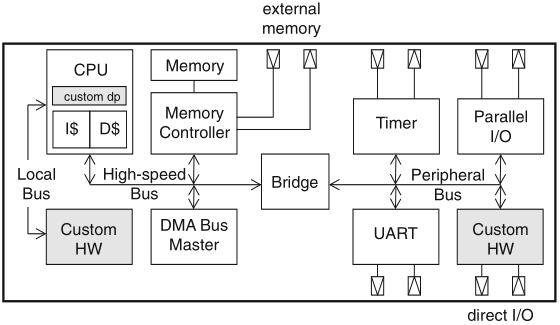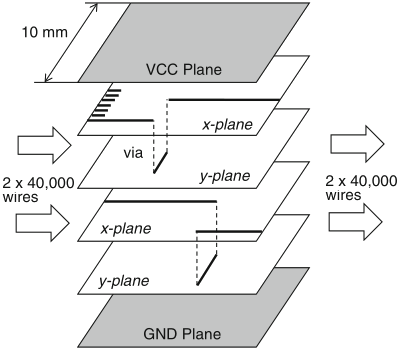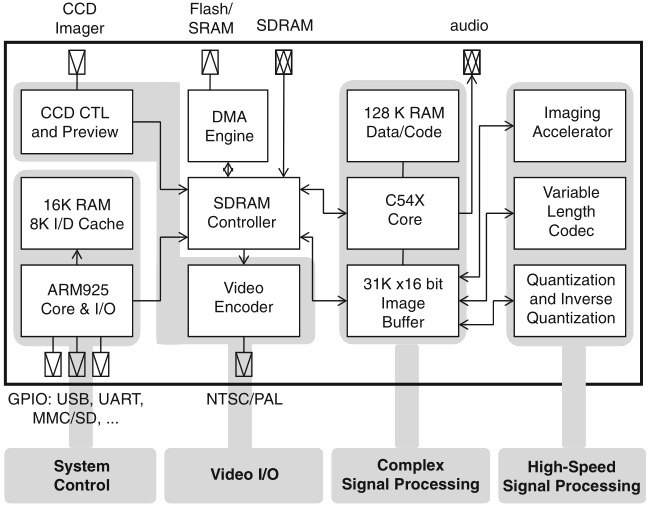DMI – Graduate Course in Computer Science
Copyleft
![]() 2018 Giuseppe Scollo
2018 Giuseppe Scollo
outline:
SoC: a domain-specialized platform on a single chip
domain examples:
video-processing application examples:
advantages of domain specialization:
four orthogonal dimensions of analysis of the organization and interplay of components in a SoC:

Schaumont, Figure 8.1 - Generic template for a system-on-chip
in this generic architecture:
shaded blocks in fig. 8.1 show three ways to attach custom hardware in a SoC context
in SoC design, there is no single best way to integrate hardware and software
factors to trade-off in SoC design include:
four design principles for any SoC:
hardware heterogeneity : FSMDs, microprogrammed engines, RISC microprocessors
task-level parallelism is possible in a SoC thanks to their multiplicity
functional heterogeneity : computationally different units
thanks to parallelism at all levels a SoC can fully exploit the hardware technology, in two respects:
multiple bus segments using bus bridges may prevent the central bus bottleneck

Schaumont, Figure 8.2 - Demonstration of the routing density in a six-layer metal 90 nm CMOS chip
an example by Tensilica founder Chris Rowen about extremely high bandwidth of on-chip communication:
assumptions:
→ a theoretical bandwidth of 40 Tbps!
off-chip communication is orders of magnitude below
heterogeneity of silicon-based memories in a SoC is summarized in Table 8.1
| Type |
Register Register file |
DRAM |
SRAM |
NVROM (ROM, PROM, EPROM) |
NVRAM (Flash, EEPROM) |
| Cell size (bit) | 10 transistors | 1 transistor | 4 transistors | 1 transistor | 1 transistor |
| Retention | 0 | Tens of ms | 0 | ∞ | 10 years |
| Addressing | Implicit | Multiplexed | Non-muxed | Non-muxed | Non-muxed |
| Access time | < 1 ns | < 20 ns | < 10 ns | 20 ns | 20 ns (read) 100 μs (write) |
| Power consumption | High | Low | High | Very low | Very low |
| Write durability | ∞ | ∞ | ∞ | ∞ | One million times |
Schaumont, Table 8.1 - Types of memories
distributed storage significantly complicates the concept of a centralized memory address space, when data need to be shared among components
a control hierarchy among components ensures that the entire SoC operates as a single logical entity
local control may be played by dedicated components, such as coprocessors or other custom hardware, but their operations and those of the central controller are not entirely independent
the design of a good control hierarchy is a challenging problem
depending on the workload distribution, any component may cause a system bottleneck–the challenge for the SoC designer (or platform programmer) is to be aware of the location of such system bottlenecks, and to control them
real case study: a digital media processor by Texas Instruments

Schaumont, Figure 8.3- Block diagram of portable multi-media system
several device modes, including:
four specialized subsystems are shaded in figure 8.3, centered around the SDRAM controller which organizes the traffic to the large, off-chip memory holding image data
the previously discussed four properties can be recognized in this chip: